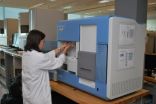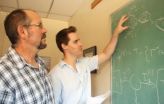(Press-News.org) As researchers and policymakers work toward an effective HIV vaccine in a constrained global economy, cost-effective prevention strategies such as Couples Voluntary Counseling and Testing (CVCT) must take a larger role in efforts to decrease the rates of HIV/AIDS in Africa, says Emory University HIV/AIDS vaccine researcher Susan Allen, MD, MPH.
Allen, who has worked to combat the AIDS epidemic in Africa for more than 25 years, highlighted the value of CVCT and other cost-effective HIV prevention strategies today at the AIDS Vaccine 2010 Conference in Atlanta.
"The majority of new HIV infections are acquired from a spouse, and couples are the largest HIV risk group in Africa," says Allen, a professor of pathology and laboratory medicine in the Emory School of Medicine and adjunct faculty member in the Rollins School of Public Health. "By using CVCT to identify those people who do not share the same HIV status as their spouse or partner, we're in a better place to move forward efficiently and effectively once a vaccine does become available."
Allen, founder of the Rwanda Zambia HIV Research Group (RZHRG), notes that the positive impact of CVCT has been supported by published evidence since the early 1990s, yet the program has not yet been implemented on a wide scale. Of more than 30 million Africans tested for HIV, less than one percent has been tested with their spouses, says Allen.
"Funding agencies are only now beginning to understand and appreciate the value of CVCT as part of a broader HIV/AIDS strategy," Allen says.
An estimated 23 million Africans are HIV positive, yet only 3 million are receiving antiretroviral treatment (ARVT). The World Health Organization calculates that for every two new ARVT patients, five new HIV infections occur.
The U.S. government spends approximately $2.2 billion – 10 percent of the entire U.S. bilateral foreign assistance budget – on antiretroviral treatment. Treating one ARVT patient for 10 years costs about $7,000. In comparison, providing couples with voluntary counseling and testing would prevent new HIV infections at a cost of about $300 each, and would leverage other vital programs such as family planning, Allen says.
"The population of Zambia, for example, has grown by more than 50 percent over the last 20 years, but the U.S. has only allocated about 1.3 percent of its budget for family planning. At the same time, more than 60 percent of these budgets have been earmarked for antiretroviral drugs and care, even though less than two percent of the population is on ARVT."
As the population steadily increases, Allen says, funding agencies will face even more pressure to use their funds wisely.
"CVCT is an economical, sustainable and proven model for reducing the rate of HIV/AIDS infections in Africa."
###
The Robert W. Woodruff Health Sciences Center of Emory University is an academic health science and service center focused on missions of teaching, research, health care and public service. Its components include the Emory University School of Medicine, Nell Hodgson Woodruff School of Nursing, and Rollins School of Public Health; Yerkes National Primate Research Center; Winship Cancer Institute of Emory University; and Emory Healthcare, the largest, most comprehensive health system in Georgia. Emory Healthcare includes: The Emory Clinic, Emory-Children's Center, Emory University Hospital, Emory University Hospital Midtown, Wesley Woods Center, and Emory University Orthopaedics & Spine Hospital. The Woodruff Health Sciences Center has $2.3 billion in operating expenses, 18,000 employees, 2,500 full-time and 1,500 affiliated faculty, 4,500 students and trainees, and a $5.7 billion economic impact on metro Atlanta. Learn more about Emory's health sciences: http://emoryhealthblog.com - @emoryhealthsci (Twitter) - http://emoryhealthsciences.org
Testing African couples for HIV is cost-effective prevention strategy
2010-10-01
ELSE PRESS RELEASES FROM THIS DATE:
Chromosomal break gives scientists a break in finding new puberty gene
2010-10-01
A break in the two chromosomes has given scientists a break in finding a new gene involved in puberty, Medical College of Georgia researchers report.
It's also helped clear up why some patients with delayed puberty have no sense of smell, said Dr. Lawrence C. Layman, chief of the MCG Section of Reproductive Endocrinology, Infertility and Genetics.
The WRD11 gene interacts with a transcription factor that appears to be involved in development of gonadotropin releasing hormones that enable sexual maturation as well as olfactory neurons in the brain, according to a study ...
Bedouin tribe reveals secrets to McGill's GA-JOE
2010-10-01
Van Den Ende-Gupta syndrome (VDEGS) is an extremely rare genetic disorder that is characterized by distinctive head and facial features, such as unusual eyelids, narrow and beaked noses, flat nasal bridges, jaw deformities, and a turned out lower lip. As part of McGill's "RaDiCAL" project (Rare Disease Consortium for Autosomal Loci), collaborators in Qatar conducted field research with three patients from biologically interrelated Bedouin families, and sent samples to Canada for analysis by GA JOE – a high-tech genome analyzing machine. The research effort was led by husband ...
Key leukemia defense mechanism discovered by VCU Massey Cancer Center
2010-10-01
Richmond, Va. (September 30, 2010) – Virginia Commonwealth University Massey Cancer Center researcher Steven Grant, M.D., and a team of VCU Massey researchers have uncovered the mechanism by which leukemia cells trigger a protective response when exposed to a class of cancer-killing agents known as histone deacetylase inhibitors (HDACIs). The findings, published in the Journal of Biological Chemistry, could lead to more effective treatments in patients with leukemia and other cancers of the blood.
"Our findings provide new insights into the ways such cancer cells develop ...
'Great strides' in treatment of stroke, headache, epilepsy
2010-10-01
MAYWOOD, Il. -- The latest advances in treating neurologic disorders such as stroke, headache, Parkinson's disease, epilepsy and sleep disorders are detailed in a special issue of the journal Neurologic Clinics.
Guest editor is Dr. Jose Biller, chairman of the Department of Neurology at Loyola University Chicago Stritch School of Medicine.
"Great therapeutic strides in the clinical neurosciences have been made in the past decades," Biller wrote in the preface to the November 2010 issue, now available online. "It is likely that subsequent decades will bring even greater ...
OHSU Toxicology Research Center issues public alert on popular hair salon treatment
2010-10-01
PORTLAND, Ore. — Oregon Health & Science University's Center for Research on Occupational and Environmental Toxicology (CROET) is responding to concerns raised by Portland-area hair salons about a product used for hair straightening. CROET has issued two public alerts describing its findings on the possible negative health impacts of this product.
The product being tested is called Brazilian Blowout. After receiving two samples from Portland-area salons, CROET asked the Department of Consumer and Business Services' Oregon Occupational Safety & Health Division to chemically ...
October 2010 Geology and GSA Today highlights
2010-10-01
Boulder, CO, USA – The October Geology includes a study using fish teeth to understand ocean circulation; discussion of the "Dead Clade Walking" taxa; description of the first reported example of igneous aragonite; discovery of a Paleogene California River, flowing in similar location but opposite direction to the Colorado River; a report of the earliest definite record of predation on pelagic sea lilies; and discovery of the only known active drumlin field in the world. GSA Today examines calderas.
Relationship between mass extinction and iridium across the Cretaceous-Paleogene ...
Turning waste heat into power
2010-10-01
What do a car engine, a power plant, a factory and a solar panel have in common? They all generate heat – a lot of which is wasted.
University of Arizona physicists have discovered a new way of harvesting waste heat and turning it into electrical power.
Using a theoretical model of a so-called molecular thermoelectric device, the technology holds great promise for making cars, power plants, factories and solar panels more efficient, to name a few possible applications. In addition, more efficient thermoelectric materials would make ozone-depleting chlorofluorocarbons, ...
New report on street lighting technologies available from NLPIP at Rensselaer Polytechnic Institute
2010-10-01
Troy, N.Y. – The National Lighting Product Information Program (NLPIP) released its latest Specifier Report, designed to provide objective performance information on existing street lighting technologies -- including light-emitting diode (LED), induction, and high pressure sodium (HPS) streetlights. This report comes at a critical time when many municipalities, some with funding from the American Recovery and Reinvestment Act of 2009, are in the process of replacing HPS streetlights with LED and induction models.
NLPIP, established by Rensselaer Polytechnic Institute's ...
Newly discovered planet may have water on its surface
2010-10-01
A team of astronomers that includes the University of Hawaiʻi' at Manoa's Nader Haghighipour has announced the discovery of a planet that could have liquid water on its surface.
The planet, which is probably 30 percent larger than Earth, was discovered using one of the telescopes of the W. M. Keck Observatory on Mauna Kea. It orbits a relatively small star, Gliese 581, that is 20 light-years from Earth in the constellation Libra.
"By determining the orbit of this planet, we can deduce that its surface temperature is similar to that of Earth," said Haghighipour. ...
NOAA-sponsored scientists first to map offshore San Andreas Fault and associated ecosystems
2010-10-01
For the first time, scientists are using advanced technology and an innovative vessel to study, image, and map the unexplored offshore Northern San Andreas Fault from north of San Francisco to its termination at the junction of three tectonic plates off Mendocino, Calif.
The team includes scientists from NOAA's National Marine Fisheries Service, Oregon State University, the California Seafloor Mapping Program, the U.S. Geological Survey and Woods Hole Oceanographic Institution. The expedition which concludes Sunday is sponsored by NOAA's Office of Ocean Exploration and ...


